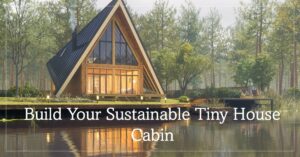Tiny House Kits Unveiled: Your Blueprint to DIY Dream Living
Imagine a life where your living space is perfectly tailored to your needs, every square foot is intentional, and you know you built it yourself.
For those intrigued by the idea of tiny living and the hands-on appeal of DIY projects, the world of tiny house kits offers a gateway to this dream.
The Allure of Tiny Living
Tiny living has captured the hearts of many, and it’s not hard to see why. It’s about simplifying life, reducing clutter, and living more sustainably. The charm lies in the creative use of space, the reduction in environmental impact, and the freedom to live on your terms. If this resonates with you, exploring tiny house kits might be the first step towards a transformative lifestyle.
Tiny house kits for the do-it-yourself (DIY) crowd are alluring for several compelling reasons:
- Affordability: Building a traditional home can be expensive, but tiny house kits are typically more budget-friendly. They offer a cost-effective way to own a home without the burden of a large mortgage.
- Customization: Tiny house kits often come with a range of customization options. DIY enthusiasts can tailor their tiny homes to their specific needs and design preferences, creating a unique living space that reflects their personality.
- Sense of Accomplishment: Completing a DIY project like building a tiny house provides a profound sense of accomplishment. It’s a tangible result of your hard work and creativity, boosting self-esteem and satisfaction.
- Hands-On Learning: Building a tiny house is an educational journey. DIY builders acquire valuable skills in construction, carpentry, plumbing, electrical work, and more. This knowledge can be applied to future projects or even a career change.
- Environmental Sustainability: Tiny houses are often designed to be energy-efficient and eco-friendly. For environmentally-conscious individuals, building a tiny house aligns with their values by reducing their carbon footprint.
- Minimalism and Downsizing: Many people are drawn to the minimalist lifestyle promoted by Tiny Living. Downsizing possessions and living in a smaller space encourages a clutter-free, simplified life with fewer material possessions.
- Self-Sufficiency: DIY tiny housebuilders often install off-grid solar panels, composting toilets, and rainwater collection. This self-sufficiency can reduce reliance on public utilities and provide a sense of autonomy.
- Flexibility and Mobility: Tiny houses on wheels offer the freedom to relocate your home. This mobility can appeal to those who desire a nomadic lifestyle or want to change their living environment easily.
- Community and Connection: The tiny house movement has a strong sense of community. Enthusiasts connect with like-minded individuals, attend tiny house festivals, and share experiences and advice, fostering a sense of belonging.
- Financial Freedom: With lower housing costs, tiny house owners often have more financial freedom. They can allocate resources to experiences, travel, or pursuing their passions rather than being tied down by a mortgage.
- Reduced Maintenance: Smaller living spaces typically require less maintenance and cleaning, freeing up time for other pursuits and reducing the stress of homeownership.
- Minimal Environmental Impact: Tiny houses generally have a smaller ecological footprint due to their reduced size and resource-efficient design, making them a more sustainable housing option.
- Escape from Consumerism: Tiny living encourages a shift away from consumerism and the accumulation of material possessions, promoting a focus on experiences and meaningful relationships instead.
In summary, tiny house kits for the DIY crowd are alluring because they offer a blend of financial benefits, customization opportunities, self-sufficiency, and a chance to embrace a simplified, eco-conscious lifestyle while fostering a strong sense of accomplishment and community. These factors collectively make tiny house living an attractive choice for those seeking an alternative way of life.
There’s something uniquely rewarding about crafting your living space from the ground up. DIY tiny house kits cater to those who relish getting their hands dirty, make design choices that reflect their personality, and revel in the accomplishment of completing a challenging project.
Affordability and Control
One of the critical considerations for anyone looking to embark on a tiny house journey is cost. Tiny houses are often more affordable than traditional homes, and DIY kits can further reduce expenses. With these kits, you save on labor costs and control the materials’ quality and the final design.
Here’s a table of items you might need for a tiny house kit for the do-it-yourself crowd, along with sample prices and a brief description of what each item is used for.
| Item | Sample Price | Description |
| Tiny House Kit | $10,000 – $30,000 | The core package includes the basic structure and materials for the tiny house. It forms the foundation of your project. |
| Trailer (if on wheels) | $2,000 – $5,000 | A trailer forms the base of a mobile tiny house. It should be sturdy and suitable for your tiny house’s size and weight. |
| Tools and Equipment | $500 – $2,000 | Various tools like saws, drills, hammers, measuring tools, and safety gear needed for construction. |
| Plumbing Fixtures | $500 – $2,000 | Sink, faucet, shower, toilet, pipes, and fittings for the plumbing system. |
| Electrical Components | $500 – $1,500 | Wiring, outlets, switches, circuit breakers, and lighting fixtures for the electrical system. |
| Insulation | $500 – $2,000 | Insulation materials like foam board, fiberglass, or spray foam to maintain a comfortable indoor temperature. |
| Windows and Doors | $1,000 – $3,000 | Windows for natural light and ventilation, and doors for entry/exit. |
| Flooring | $500 – $1,500 | Materials such as hardwood, laminate, or vinyl flooring. |
| Roofing Materials | $1,000 – $3,000 | Roofing materials like metal or shingles to protect your tiny house from the elements. |
| Exterior Siding | $1,000 – $3,000 | Siding materials such as wood, vinyl, or metal for the exterior finish. |
| Kitchen Appliances | $1,000 – $3,000 | Appliances like a refrigerator, stove, oven, and microwave if you plan to have a kitchen. |
| Interior Fixtures | $500 – $1,500 | Cabinetry, shelving, and other interior fixtures for storage and organization. |
| Heating and Cooling | $500 – $2,000 | Heating and cooling systems like a mini-split AC unit, wood stove, or radiant floor heating. |
| Solar Panels (optional) | $3,000 – $10,000 | Solar panels and components for an off-grid or energy-efficient setup. |
| Water Heater (optional) | $500 – $1,500 | A water heater for hot water supply, if not using an on-demand system. |
| Septic System (optional) | $1,000 – $4,000 | A septic system for waste disposal, if not connecting to a sewage system. |
Please remember that these prices are approximate and can vary significantly based on factors like your location, the quality of materials, and the level of customization in your tiny house. Researching and planning your project thoroughly is essential for an accurate budget estimate for your specific needs and preferences.
Convenience Without Sacrificing Creativity
While building your tiny house from scratch may sound enticing, it can be daunting. This is where tiny house kits shine. They provide pre-cut materials, comprehensive instructions, and all the necessary components to assemble your dream home. It’s a harmonious blend of convenience and creativity, enabling you to focus on the most aspects you love – personalization and design.
You can find samples of DIY tiny house kits and explore various options at the following websites and online marketplaces:
- Tiny Home Builders (tinyhomebuilders.com): This website offers a variety of tiny house plans and kits, along with resources for DIY builders.
- Tumbleweed Tiny House Company (tumbleweedhouses.com): Tumbleweed is known for its high-quality tiny house kits, and you can explore their designs and kits on their website.
- B&B Micro Manufacturing (bbtinyhouses.com): B&B Micro Manufacturing specializes in tiny house kits and provides information about their offerings on their website.
- Etsy (etsy.com): Etsy often features tiny house kit sellers offering plans, materials, and pre-fabricated components.
- Amazon (amazon.com): You can find a range of tiny house kits and related materials on Amazon.
- Tiny House Marketplace (tinyhousemarketplace.com): This platform allows you to browse listings for tiny house kits and even fully-built tiny homes.
- Tiny House Listings (tinyhouselistings.com): While primarily a marketplace for tiny homes, you can also find listings for tiny house kits and plans.
- Tiny House Talk (tinyhousetalk.com): This website regularly features articles and resources related to tiny house kits and plans, often with links to sellers.
- Local Builders and Workshops: Check if local tiny house builders or workshops in your area offer kits or guidance for DIY builders.
Remember to thoroughly research each option, read reviews, and compare prices and features to find the DIY tiny house kit that best suits your needs and preferences.
Tailored to Your Tastes
Customization is a hallmark of tiny house kits. They come in various shapes and sizes, allowing you to choose a layout that suits your lifestyle. From the type of roofing to the flooring materials, you can tailor every detail to your preferences, ensuring that your tiny home truly reflects who you are.
Navigating Legalities and Safety
Building your tiny house isn’t just about hammers and nails; it’s also about complying with local building codes and ensuring safety. Many tiny house kits are designed with these considerations, guiding you through the process and helping you meet legal requirements without the headaches.
Building a DIY tiny house can be a rewarding and liberating experience. Still, navigating the legalities and adhering to safety guidelines is essential to ensure a safe and compliant living space. Here, we’ll explore some key considerations:
1. Local Building Codes and Zoning Laws:
● Before you begin construction, research your local building codes and zoning regulations. These regulations dictate the size, placement, and use of structures on your property.
● Verify if your area allows tiny houses as primary residences or if they are categorized as accessory dwelling units (ADUs). Understanding these designations is crucial as they affect where to place your tiny house and whether it must comply with specific codes.
2. Permits and Inspections:
● Depending on your location and the intended use of your tiny house, you may need various permits, such as building permits, plumbing permits, electrical permits, and occupancy permits.
● Schedule inspections as required during different stages of construction to ensure your tiny house meets safety standards and local codes.
3. Foundation and Trailer Regulations:
● If your tiny house is on wheels, you must adhere to regulations governing trailers, including weight limits and safety features. Ensure the trailer is appropriately rated for your tiny house’s size and weight.
● If your tiny house is on a permanent foundation, it must meet local building codes for foundations, footings, and anchoring.
4. Utilities and Off-Grid Considerations:
● Ensure that your electrical, plumbing, and wastewater systems comply with safety standards. Hiring professionals for these installations may be necessary to meet code requirements.
● If you plan to go off-grid, research alternative energy sources (e.g., solar panels) and sustainable waste disposal options (e.g., composting toilets).
5. Safety Standards and Materials:
● Use materials that meet safety and fire-resistant standards. This includes materials for insulation, roofing, siding, and interior finishes.
● Pay close attention to safety measures during construction. Follow guidelines for structural integrity, securing heavy items during travel (for mobile tiny houses), and installing smoke and carbon monoxide detectors.
6. Land and Lease Agreements:
● If you plan to park your tiny house on someone else’s property, establish clear agreements and lease terms with the property owner. Verify that the location complies with local zoning laws.
● If you’re part of a tiny house community or park, familiarize yourself with their rules and regulations.
7. Insurance and Liability:
● Consult with an insurance agent to discuss coverage options for your tiny house during construction and when it’s completed. Liability insurance is crucial in case of accidents or injuries.
8. Transportation Regulations (for mobile tiny houses):
● If your tiny house is on wheels, be aware of transportation regulations, including weight limits, width restrictions, and towing requirements.
Navigating DIY tiny house kits’ legalities and safety guidelines requires diligence and research. Consulting with local authorities, professionals, and experienced builders can provide valuable insights and guidance throughout your tiny house construction journey. Ultimately, a well-planned and legally compliant tiny house ensures your safety and peace of mind in your new, compact home.
The Quest for the Perfect Kit
With the growing popularity of tiny living, an array of tiny house kits is available. Your search involves finding the right kit, assessing your needs, and envisioning your ideal home. Reading reviews, seeking recommendations, and attending tiny house workshops can be invaluable in making an informed choice.
The DIY Tiny House Journey
Once you’ve chosen your kit, the real adventure begins. Building a tiny house is a step-by-step process that involves everything from framing to plumbing and electrical work. While challenges may arise, the rewards are immeasurable. Completing your tiny home is a testament to your skills, determination, and vision.
Joining the Tiny House Community
The world of tiny living is about the house and the community. Engaging with fellow tiny house enthusiasts, attending workshops, and sharing your own experiences can enrich your journey and provide you with a support system that understands the unique challenges and joys of tiny living.
In conclusion, tiny house kits open up possibilities for those who dream of simplifying their lives, building their homes, and embracing a more sustainable lifestyle. Whether you’re drawn to the affordability, the creative process, or the sense of community, exploring tiny house kits is a step towards turning your dream into a reality. So, why wait? Your DIY tiny house adventure awaits!


